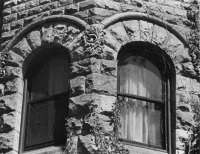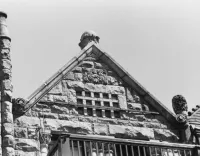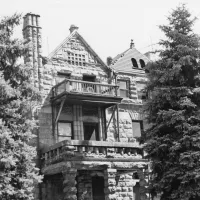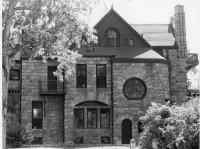Share what you know,
and discover more.
Share what you know,
and discover more.
Nov 21, 1974
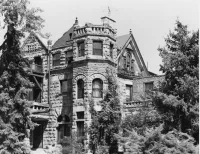
-

- Charmaine Bantugan
National Register of Historic Places - Wilbur S. Raymond House (The Marne)
Statement of Significant: The Marne house fully portrays an era of Denver history characterized by the variety and beauty of architectural styles, in this case, the complex eclectic style of William Lang. "The fact that men are ablete build and maintain such homes and the further fact that they possess the taste for these elegant domestic surroundings, prove to the world that Denver has reached the social age in which refinement, culture and love of the beautiful stamp the character of the people" - Denver Republican, January 1, 1890. Wilbur S. Raymond, an investment banker, built the house in 1889- 1890 during a building boom in Denver. The house cost approximately $30,000 to build on land purchase for $15,000. Raymond's later financial difficulties resulted in the sale of the house less than two years after its completion at a price of $40,000. John Mason bought it in 1895 after two additional intervening owners. Mr. Mason and his wife, Frances, emigrants from Texas, had accumulated a fortune. Mr. Mason was reported to be very colorful and flamboyant but also sincere. Mrs. Mason was a quiet person although entertain- ing frequently. Mason's professional life is obscure or non-existent after coming to Denver preferring to study nature, hunt and fish. He amassed a large collection of butterflies exhibited on the third floor of the house. This collection is now in the Colorado Natural History Museum. After Mrs. Mason died Mr. Mason married Dera Porter, daughter of the socially prominent Henry M. Perters who were responsible for the establishment of Perter Sanitarium in Englewood. In 1918 Adele Van Cise, widow of Edwin Van Cise, bought the house from Dera Mason. Philip Van Cise, her son, named the house "The Marne" Stories indicating members of the family were involved in the Battle of the Marne during World War I are incorrect. The Van Cise family has contributed heavily to the Denver legal community. Edwin Van Cise headed the Philosophical Society of Denver, the Public Utilities Commission for the city, and for years was a lecturer in the law for the University of Colorado. He died in 1914. His sen, Philip, was an attorney for the Rocky Mountain News during the Bonfils scandal, a Denver District Attorney, and author. His grandson, Edwin a successful trial lawyer, is presently a justice on the Colorade Court of Appeals. Mrs. Van Cise converted the house inte apartments which were rented. She added a new wing in 1920. Mrs. Van Cise lived in the house until her death in 1938. In 1939 Mr. Lyle A. Holland bought the house, Mrs. Van Cise's daughter, Ethel, and sold the house July 1954, 29, to a partnership which plans to restore the house. While the contributions of the residents of the Marne to the growth and development of Denver is considerable, the building's greater significance lies in its status as perhaps the finest example, and one of the very few remaining examples, of the work of an architect whose buildings reflected the spirit of the city in its most exciting period of growth and development. The following analysis of Lang and his work is taken from Historic Denver 1858-1893, by Richard R. Brettell. "William Lang was undoubtedly the most popular and prolific designer of domestic architecture in nineteenth century Denver. His houses ranged from cottages to mansions and were constructed in every part of Denver and in most of the city's nineteenth century suburbs. In 1890, the Western Architect and Building News listed 43 houses designed by William Lang and his partner, Marshall Pugh, as well as several terraces, a store, a town hall, and an apartment hotel. One of Lang's larger stone houses, the Raymond house on the corner of 16th and Race Streets (the Marne), was prominently featured in that periodical, and frequent mention of Lang indicates his popularity within Denver's burgeoning and self-conscious architectural profession. His name appears as one of the charter members of the Colorado Chapter of the American Institute of Architects, established in 1892. "Lang was, undoubtedly, the most self-consciously eclectic architect in the city of Denver. He never built a building in a clear, nameable style and was an architect who conceived of a building as a combination of architectural elements derived from a great many other buildings. In short, his architecture was absolutely unique and absolutely evasive. It was so eclectic in its combinative powers that the modern viewer is generally left with what must be an object with so many borrowings from so many different types of sources--of so many different kinds that the sources can never be fully acknowledged. William Lang was probably a master eclectic. He was certainly the finest and most complex eclectic architect who worked in Denver and, though his work is not at all well-known, he may have been one of the best late eclectic architects in the United States."
National Register of Historic Places - Wilbur S. Raymond House (The Marne)
Statement of Significant: The Marne house fully portrays an era of Denver history characterized by the variety and beauty of architectural styles, in this case, the complex eclectic style of William Lang. "The fact that men are ablete build and maintain such homes and the further fact that they possess the taste for these elegant domestic surroundings, prove to the world that Denver has reached the social age in which refinement, culture and love of the beautiful stamp the character of the people" - Denver Republican, January 1, 1890. Wilbur S. Raymond, an investment banker, built the house in 1889- 1890 during a building boom in Denver. The house cost approximately $30,000 to build on land purchase for $15,000. Raymond's later financial difficulties resulted in the sale of the house less than two years after its completion at a price of $40,000. John Mason bought it in 1895 after two additional intervening owners. Mr. Mason and his wife, Frances, emigrants from Texas, had accumulated a fortune. Mr. Mason was reported to be very colorful and flamboyant but also sincere. Mrs. Mason was a quiet person although entertain- ing frequently. Mason's professional life is obscure or non-existent after coming to Denver preferring to study nature, hunt and fish. He amassed a large collection of butterflies exhibited on the third floor of the house. This collection is now in the Colorado Natural History Museum. After Mrs. Mason died Mr. Mason married Dera Porter, daughter of the socially prominent Henry M. Perters who were responsible for the establishment of Perter Sanitarium in Englewood. In 1918 Adele Van Cise, widow of Edwin Van Cise, bought the house from Dera Mason. Philip Van Cise, her son, named the house "The Marne" Stories indicating members of the family were involved in the Battle of the Marne during World War I are incorrect. The Van Cise family has contributed heavily to the Denver legal community. Edwin Van Cise headed the Philosophical Society of Denver, the Public Utilities Commission for the city, and for years was a lecturer in the law for the University of Colorado. He died in 1914. His sen, Philip, was an attorney for the Rocky Mountain News during the Bonfils scandal, a Denver District Attorney, and author. His grandson, Edwin a successful trial lawyer, is presently a justice on the Colorade Court of Appeals. Mrs. Van Cise converted the house inte apartments which were rented. She added a new wing in 1920. Mrs. Van Cise lived in the house until her death in 1938. In 1939 Mr. Lyle A. Holland bought the house, Mrs. Van Cise's daughter, Ethel, and sold the house July 1954, 29, to a partnership which plans to restore the house. While the contributions of the residents of the Marne to the growth and development of Denver is considerable, the building's greater significance lies in its status as perhaps the finest example, and one of the very few remaining examples, of the work of an architect whose buildings reflected the spirit of the city in its most exciting period of growth and development. The following analysis of Lang and his work is taken from Historic Denver 1858-1893, by Richard R. Brettell. "William Lang was undoubtedly the most popular and prolific designer of domestic architecture in nineteenth century Denver. His houses ranged from cottages to mansions and were constructed in every part of Denver and in most of the city's nineteenth century suburbs. In 1890, the Western Architect and Building News listed 43 houses designed by William Lang and his partner, Marshall Pugh, as well as several terraces, a store, a town hall, and an apartment hotel. One of Lang's larger stone houses, the Raymond house on the corner of 16th and Race Streets (the Marne), was prominently featured in that periodical, and frequent mention of Lang indicates his popularity within Denver's burgeoning and self-conscious architectural profession. His name appears as one of the charter members of the Colorado Chapter of the American Institute of Architects, established in 1892. "Lang was, undoubtedly, the most self-consciously eclectic architect in the city of Denver. He never built a building in a clear, nameable style and was an architect who conceived of a building as a combination of architectural elements derived from a great many other buildings. In short, his architecture was absolutely unique and absolutely evasive. It was so eclectic in its combinative powers that the modern viewer is generally left with what must be an object with so many borrowings from so many different types of sources--of so many different kinds that the sources can never be fully acknowledged. William Lang was probably a master eclectic. He was certainly the finest and most complex eclectic architect who worked in Denver and, though his work is not at all well-known, he may have been one of the best late eclectic architects in the United States."
Nov 21, 1974
National Register of Historic Places - Wilbur S. Raymond House (The Marne)
Statement of Significant:The Marne house fully portrays an era of Denver history characterized by the variety and beauty of architectural styles, in this case, the complex eclectic style of William Lang. "The fact that men are ablete build and maintain such homes and the further fact that they possess the taste for these elegant domestic surroundings, prove to the world that Denver has reached the social age in which refinement, culture and love of the beautiful stamp the character of the people" - Denver Republican, January 1, 1890.
Wilbur S. Raymond, an investment banker, built the house in 1889- 1890 during a building boom in Denver. The house cost approximately $30,000 to build on land purchase for $15,000. Raymond's later financial difficulties resulted in the sale of the house less than two years after its completion at a price of $40,000. John Mason bought it in 1895 after two additional intervening owners.
Mr. Mason and his wife, Frances, emigrants from Texas, had accumulated a fortune. Mr. Mason was reported to be very colorful and flamboyant but also sincere. Mrs. Mason was a quiet person although entertain- ing frequently. Mason's professional life is obscure or non-existent after coming to Denver preferring to study nature, hunt and fish. He amassed a large collection of butterflies exhibited on the third floor of the house. This collection is now in the Colorado Natural History Museum.
After Mrs. Mason died Mr. Mason married Dera Porter, daughter of the socially prominent Henry M. Perters who were responsible for the establishment of Perter Sanitarium in Englewood.
In 1918 Adele Van Cise, widow of Edwin Van Cise, bought the house from Dera Mason. Philip Van Cise, her son, named the house "The Marne" Stories indicating members of the family were involved in the Battle of the Marne during World War I are incorrect.
The Van Cise family has contributed heavily to the Denver legal community. Edwin Van Cise headed the Philosophical Society of Denver, the Public Utilities Commission for the city, and for years was a lecturer in the law for the University of Colorado. He died in 1914. His sen, Philip, was an attorney for the Rocky Mountain News during the Bonfils scandal, a Denver District Attorney, and author. His grandson, Edwin a successful trial lawyer, is presently a justice on the Colorade Court of Appeals.
Mrs. Van Cise converted the house inte apartments which were rented. She added a new wing in 1920. Mrs. Van Cise lived in the house until her death in 1938. In 1939 Mr. Lyle A. Holland bought the house, Mrs. Van Cise's daughter, Ethel, and sold the house July 1954, 29, to a partnership which plans to restore the house.
While the contributions of the residents of the Marne to the growth and development of Denver is considerable, the building's greater significance lies in its status as perhaps the finest example, and one of the very few remaining examples, of the work of an architect whose buildings reflected the spirit of the city in its most exciting period of growth and development. The following analysis of Lang and his work is taken from Historic Denver 1858-1893, by Richard R. Brettell.
"William Lang was undoubtedly the most popular and prolific designer of domestic architecture in nineteenth century Denver. His houses ranged from cottages to mansions and were constructed in every part of Denver and in most of the city's nineteenth century suburbs. In 1890, the Western Architect and Building News listed 43 houses designed by William Lang and his partner, Marshall Pugh, as well as several terraces, a store, a town hall, and an apartment hotel. One of Lang's larger stone houses, the Raymond house on the corner of 16th and Race Streets (the Marne), was prominently featured in that periodical, and frequent mention of Lang indicates his popularity within Denver's burgeoning and self-conscious architectural profession. His name appears as one of the charter members of the Colorado Chapter of the American Institute of Architects, established in 1892.
"Lang was, undoubtedly, the most self-consciously eclectic architect in the city of Denver. He never built a building in a clear, nameable style and was an architect who conceived of a building as a combination of architectural elements derived from a great many other buildings. In short, his architecture was absolutely unique and absolutely evasive. It was so eclectic in its combinative powers that the modern viewer is generally left with what must be an object with so many borrowings from so many different types of sources--of so many different kinds that the sources can never be fully acknowledged. William Lang was probably a master eclectic. He was certainly the finest and most complex eclectic architect who worked in Denver and, though his work is not at all well-known, he may have been one of the best late eclectic architects in the United States."
Posted Date
Aug 01, 2023
Historical Record Date
Nov 21, 1974
Source Name
National Register of Historic Places
Source Website
Delete Story
Are you sure you want to delete this story?


